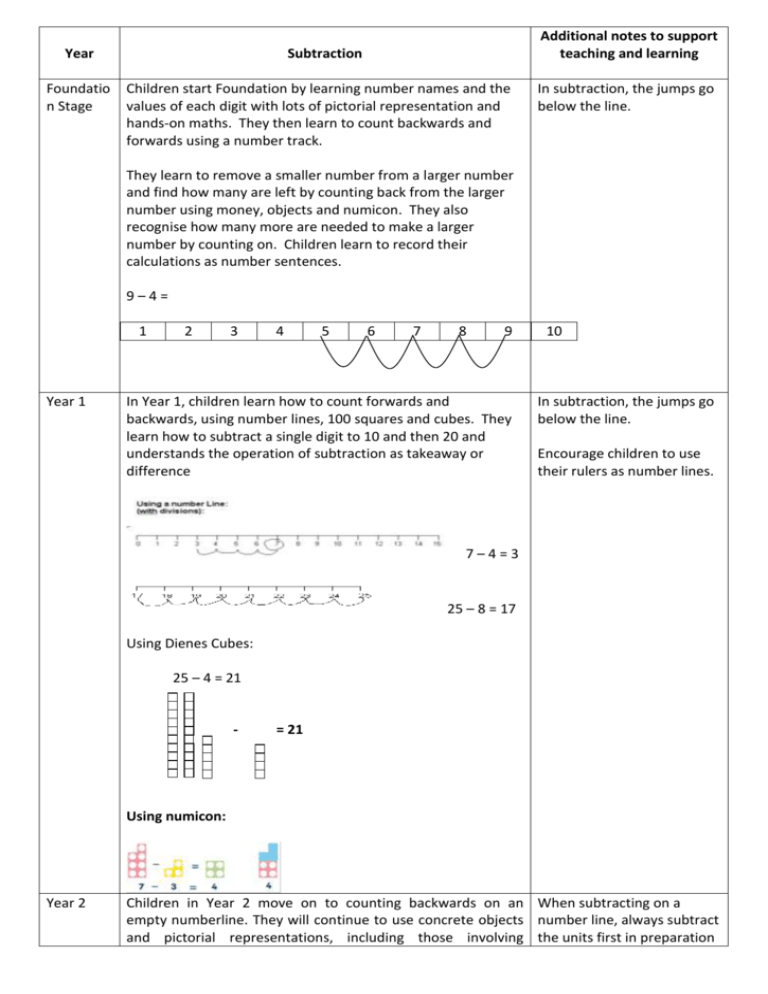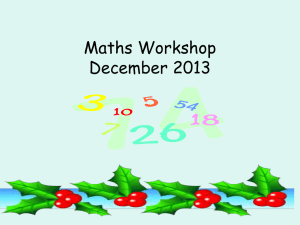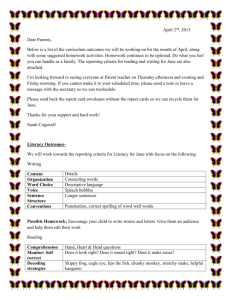Calculation progression
advertisement

Year Foundatio n Stage Additional notes to support teaching and learning Subtraction Children start Foundation by learning number names and the values of each digit with lots of pictorial representation and hands-on maths. They then learn to count backwards and forwards using a number track. In subtraction, the jumps go below the line. They learn to remove a smaller number from a larger number and find how many are left by counting back from the larger number using money, objects and numicon. They also recognise how many more are needed to make a larger number by counting on. Children learn to record their calculations as number sentences. 9–4= 1 Year 1 2 3 4 5 6 7 8 9 In Year 1, children learn how to count forwards and backwards, using number lines, 100 squares and cubes. They learn how to subtract a single digit to 10 and then 20 and understands the operation of subtraction as takeaway or difference 10 In subtraction, the jumps go below the line. Encourage children to use their rulers as number lines. 7–4=3 25 – 8 = 17 Using Dienes Cubes: 25 – 4 = 21 - = 21 Using numicon: Year 2 Children in Year 2 move on to counting backwards on an When subtracting on a empty numberline. They will continue to use concrete objects number line, always subtract and pictorial representations, including those involving the units first in preparation numbers, quantities and measures. They learn how to subtract for column subtraction. a two-digit number and units, a two-digit number and tens and two two-digit numbers It is really important that the children understand the equals sign as a sign of 15 – 7 = 8 equivalence, that what is on 8 10 15 one side of it has the same value as what is on the -2 -5 other. For example: 24 – 12 = 12 74 – 27 = 47 worked out by counting back: 12 = 24 – 12 (using the pan balance with 47 67 70 numicon is a good way of 74 teaching this). - 20 -3 -4 Children should understand that unlike addition, subtraction is not commutative (cannot be done in any order) Children should understand that difference is also subtraction. Year 3 In Year 3, children learn how to subtract numbers with up to 3 digits. They initially learn a more formal written method which is the pre-cursor to vertical subtraction. In this, the numbers are partitioned so that children can recognise the technique. Process Steps to Success – Vertical Subtraction with Partitioning Estimate the answer first. 1. Write the 2 numbers vertically where the biggest number is on the top. 2. Partition the numbers but keep them in their place value columns. 3. Start with the units and subtract the bottom number from the top number, putting the answer below the line. Continue if there are hundreds. 4. Subtract the tens digits from the one above and put the answer below the line. 75 – 32 = 43 70 30 40 5 2 3 Children move on to numbers that require decomposition (otherwise known as ‘exchanging’ or ‘borrowing’. In this, the golden rule is that if a number is bigger on the bottom then Practical resources (such as dienes or straws) should be used alongside written methods to support understanding when this method is introduced. A useful interactive resource that demonstrates this can be found at: http://www.harcourtschool. com/activity/elab2004/gr3/3 .html Children in year 3 should always estimate the answer to a calculation and use inverse operations to check answers Teaching video available at: https://www.ncetm.org.uk/r esources/40532 Children should understand that difference is also you cannot take it away from a smaller number. In the first subtraction. example below, the 8 cannot be taken away from 5, so one ten is exchanged for ten units making it 15-8=7. Process Steps to Success –Subtraction with Exchange 1. Set the sum out as shown before and estimate the answer. 2. Where the units on the bottom are bigger than the top, exchange a ten for ten units so that the number on the top is now bigger. 3. Finish the sum as normal and check against the estimate using the inverse operation. 400 130 537 – 251 = 286 500 30 7 200 50 1– 200 80 6 By the end of the year, children should have started to use the vertical subtraction method (not partitioned). See below Year 4 In Year 4, children subtract numbers with up to 4 digits using the formal written method of column (vertical) subtraction. Initially, teachers will show the expanded method alongside the short method. Process Steps to Success – Vertical Subtraction with Exchange 1. Estimate the answer first. 2. Write the 2 numbers vertically where the biggest number is on the top. 3. Keep the digits in their HTU column. 4. Start with the units and take the bottom one away from the top, putting the answer below the line. (If the top number is smaller, then one ten needs to be exchanged for ten units.) 5. Take the bottom tens digit away from the top one and put the answer below the line. (Again, if the top number is smaller, then one hundred needs to be exchanged for ten tens.) Underline the answer and then check against the estimate using the inverse operation. 5 5 6 13 4 85 1 5 Remember, if you can do the sum mentally then this is better to do so. In the example below, this would be quite awkward to do in the formal vertical method. In this case, it would be much easier to count on or back using a number line: 6,003 – 1,997 = 4,006 Practical resources (such as dienes or straws) should be used alongside written methods to support understanding when this method is introduced. A useful interactive resource that demonstrates this can be found at: http://www.harcourtschool. com/activity/elab2004/gr3/3 .html Children in year 4 should always estimate the answer to a calculation and use inverse operations to check answers. Teaching video available at: https://www.ncetm.org.uk/r esources/40532 Subtraction should also e taught through money and measure. 1997 2000 -3 Year 5 6000 - 4000 6003 -3 Year 5 learn to deal with subtraction of decimals and mixed decimals. Process Steps to Success - Vertical Subtraction with Decimals 1. Ensure tenths and hundredths are in the appropriate column. 2. Fix the decimal place between the units and tenths digits and ensure they line up (like buttons on a shirt). 3. If writing numbers in squares, put the decimal place on the line between 2 squares. 4. Complete the sum as you would for whole numbers. 3 1 £ 3. 4 5 £ 2. 2 7 £ 1. 1 8 Process Steps to Success – Vertical Subtraction with Mixed Decimals (As with decimals except it is essential that there is a place holder added if the numbers do not have the same number of decimal digits.) 1. Ensure all digits are in their place value columns. 2. Add a zero to ensure both numbers have the same number of digits after the decimal place (to hold the place value) 3. Complete the sum as you would for normal decimals starting with the numbers on the right hand side. 18.67 - 3.243 = 6 1 1 8. 6 7 0 3. 2 4 3 1 5. 4 2 7 YEAR 6 In Year 6, children consolidate their knowledge of subtraction. Children in year 5 should always estimate the answer to a calculation and use inverse operations to check answers.









